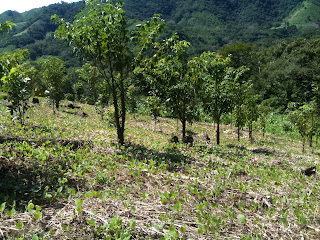In april we began site work for another tropical hardwood investment in Nicaragua. Maderas Sostenibles' staff will be planting approximately 20,000 teak trees along with 4,000 native species such as Mahogany, Royal Cedar, Spiney Cedar (pochote), Cocobolo (Rosewood dalbergia retusa) and Roble on an old coffee farm 15 kilometers outside of Managua. The higher elevation (450-600 meters) of this farm attracts more rainfall than the Managua area. The land has been rested and is covered with weed regrowth which will give better growing results than compacted cow pastures. Cash crops (beans and corn) will be planted between the trees to provide short term income and reduce planting costs. These crops also fix nitrogen and encourage faster growth. The farm was historically a coffee plantation. The coffee has been abandoned and there are different stages of re-growth and abandoned pasture present.
New investment partnership strategy
The Finca San Rafael Plantation represents a new form of investment partnership for Maderas Sostenibles. The Wheelock family has owned the farm for over 60 years. It is owned between 6 brothers and sisters whom intend to pass it on to their children as inheritance. It has been used very minimally for subsistence farming since before the civil war which started in the 1970’s. The Wheelock family is leasing 53 acres of farm for 30 years as a contribution in this partnership. Financing will come from several individual investors who will also have a stake in the planting.
For more information on how to participate in reforestation projects contact me at: aram@nicaraguahardwoods.com









